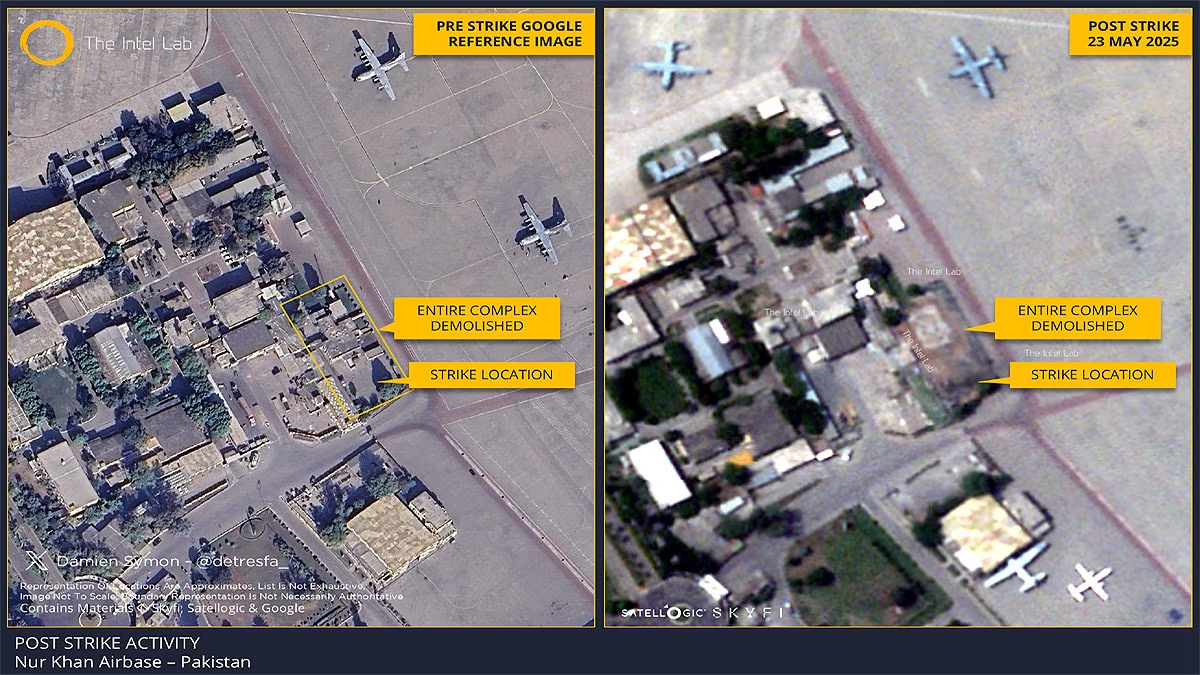Initiated on May 7, 2025, Operation Sindoor became a symbol of India's military prowess and its unwavering stance against terrorism. During this operation, the Indian Air Force (IAF) executed precision missile strikes on several Pakistani military bases, notably targeting the Nur Khan and Murid Airbases.
Satellite images from Maxar Technologies have vividly captured the aftermath of these strikes, showcasing extensive damage. At Nur Khan, an entire complex was leveled, while at Murid, the command center, along with a potential underground facility, suffered substantial harm.
Background of Operation Sindoor
Operation Sindoor was launched in response to a terrorist attack in Pahalgam, Jammu and Kashmir, on April 22, 2025, which claimed 26 lives. India attributed the attack to Pakistan-based terrorist organizations like Jaish-e-Mohammed and Lashkar-e-Taiba. On May 7, India struck nine terror targets, including in Bahawalpur, Muridke, and Muzaffarabad.
Subsequently, from May 8-10, Pakistan launched drone and missile strikes on Indian military and civilian sites, prompting India to target 11 Pakistani airbases in retaliation, with Nur Khan (Rawalpindi) and Murid (Chakwal) being prime targets.
Devastation at Nur Khan Airbase
Located in Chaklala, Rawalpindi, Nur Khan Airbase is a crucial center for the Pakistan Air Force. Situated just 10 km from the Pakistan Army Headquarters (GHQ) and Islamabad, it serves as the Air Mobility Command Headquarters, responsible for transporting troops, equipment, and VIPs. The base is home to C-130 Hercules, IL-78 refuelers, and training aircraft like the K-8.

Source: aajtak
Maxar Technologies' satellite images (May 10 and 23, 2025) reveal...
Images from May 10:
The Indian strike obliterated two specific military trucks and carved a large crater alongside the runway.
Images from May 23:
Seven days post-attack, an entire complex at Nur Khan (spanning roughly 7,000 sq. ft.) was demolished, indicating damage far exceeding initial estimates.
Extent of Damage:
According to expert Damien Symon, the strike not only targeted the designated area but also inflicted internal and structural damage on surrounding buildings. Shrapnel and fire disrupted electrical wiring and systems, rendering repairs to the complex impossible.
Strategic Impact:
Nur Khan's proximity to Pakistan's military and nuclear installations (Strategic Plans Division) meant the attack had a severe impact on Pakistan's aerial and logistic capabilities.
Strike on Murid Airbase
Nestled in Chakwal, northern Punjab, Murid Airbase serves as a forward operational base and a hub for drones and fighter aircraft. With high-end drones like Shahpar-1, Shahpar-2, Barrack, Bayraktar TB2, and Wing Loong-2 stationed here, its strategic significance is heightened being close to the Indian border.

Source: aajtak
Maxar's imagery and Damien Symon's analysis indicate...
Command and Control Building:
The building's roof suffered damage, raising concerns over potential internal damages. This building plays a pivotal role in drone and aerial operations control.
Potential Underground Facility:
An ultra-secure sub-complex, ringed by dual fencing and watchtowers, with a 3-meter-wide crater forming merely 30 meters from its entrance, suggests the presence of an underlying facility.
Targeted Significance:
This sub-complex is likely a high-value target, possibly involving equipment or storage tied to nuclear weapons.
Impact:
The strikes impeded Murid's drone operational capacity, thereby affecting Pakistan's ability to swiftly respond along its border.
Satellite Image Analysis
Images from Maxar Technologies and MizaraVision (a Chinese satellite firm) revealed the following damages...
Nur Khan:
An entire complex eradicated, two military trucks destroyed, and a crater on the runway. Extensive internal damage from fire and shrapnel.
Murid (Command Center):
Partial roof collapse and internal damage.
Murid (Sub-Complex):
A 3-meter-wide crater impacted the potential underground facility.
Images captured on May 10 and 11, with May 23 images depicting further devastation at Nur Khan. Experts argue repairs were unfeasible, leading Pakistan to demolish the complex entirely.

Source: aajtak
Widespread Impact of Operation Sindoor
Beyond obliterating terror hubs, Operation Sindoor profoundly weakened Pakistan's military might...
11 Airbases Affected:
Nur Khan, Murid, Rafiqui, Sukkur, Bholari, Jacobabad, Sargodha, Rahim Yar Khan, Sialkot, Chunian, and Skardu.
Weapons Utilized:
India deployed BrahMos, HAMMER, and SCALP missiles known for their precision and destructive power.
Pakistan's Response:
Pakistan claimed to have thwarted India's strikes, but satellite images suggest otherwise. On May 10, Pakistan's DGMO sought a ceasefire from India.
Strategic Loss:
Bases like Nur Khan and Murid are cornerstone for Pakistan's aerial and nuclear strategies. Their losses diluted Pakistan's military strength.
India's Strategy and Statements
Defense Ministry spokesperson Randhir Jaiswal asserted that the objective was to dismantle terror bases, stressing that military targets were only hit due to Pakistani military interference. Air Marshal AK Bharti praised India's precise strikes that minimized civilian damage, lauding indigenous Akash air defense systems for intercepting Pakistani drones and missiles.
Regional and Global Concerns
Nur Khan Airbase's vicinity to Pakistan's nuclear weapons security agency (Strategic Plans Division), safeguarding 170 nuclear warheads, raised questions on regional stability and nuclear security. Reports emerged of a US radiation monitoring aircraft entering Pakistan, potentially to inspect nuclear storage sites post-strikes.




